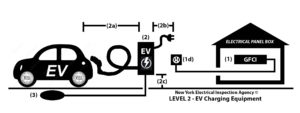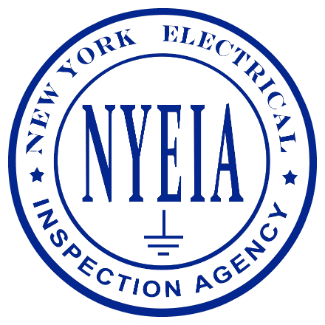As electric vehicles (EVs) become more prevalent, understanding the different levels of EV chargers and their installation requirements is essential for both consumers and installers. Currently, New York State is on the 2017 National Electrical Code (NEC). This article outlines the various levels of EV charging, their specifications, and the specific requirements for installing Level 2 EV chargers and EV wireless power transfer equipment using the 2017 NEC.
Levels of EV Charging
Electric vehicle charging infrastructure is categorized into three levels, each offering different charging speeds and suited for various applications:
Level 1 Charging Level 1 charging is the most basic form of EV charging. It uses a standard 15- or 20-amp, 120-volt household receptacle and offers a charging rate of approximately five miles of range per hour of charge. This level of charging is ideal for overnight charging at home or locations where vehicles are parked for extended periods, providing a convenient and accessible option for many EV owners.
Level 2 Charging Level 2 charging is more robust, typically requiring a power source ranging from 30 to 100 amps and 208 to 240 volts. It offers a significantly faster charging rate of about thirty-five miles of range per hour of charge. Level 2 chargers are commonly installed in residential, commercial, and public locations, providing a faster charging solution that is suitable for daily use and can fully charge most EVs within a few hours.
Level 3 Charging (DC Fast Charging) Level 3 charging, also known as DC Fast Charging, is the fastest charging option available. These systems range from 60 to 125 amps and use 3-phase 208-volt or 480-volt power sources. They offer a charging rate of up to two hundred and fifty miles of range per hour of charge, making them ideal for commercial and industrial locations. DC Fast Chargers are particularly useful for long-distance travel, allowing drivers to quickly recharge their vehicles and get back on the road.
Level 2 EV Charger Receptacle and Wiring Method Requirements
Installing a Level 2 EV charger requires adherence to specific electrical and safety standards to ensure optimal performance and safety. Currently in New York state, we are on the 2017 National Electrical Code (NEC) and here are the key requirements:
Receptacle Specifications
- GFCI Protection: All receptacle outlets with a capacity of 50 amps or less must be protected by a Ground Fault Circuit Interrupter (GFCI) to prevent electrical shock.
- Overcurrent Protection: The feeders and branch circuits must be sized for continuous duty, with a rating of at least 125% of the maximum load of the equipment. For example, a 32-amp charger must be connected to a 40-amp circuit.
- Dedicated Circuit: Any new receptacle installed specifically for EV charging must be on a dedicated circuit, meaning it cannot have any other outlets or devices connected to it.
- Weatherproof Enclosures: Receptacles installed in wet locations must be housed in weatherproof enclosures to ensure safety whether the plug is inserted or not.
Level 2 EV Charging Equipment Placement
- Charging Cord Length: The installation location must allow for a maximum 25-foot charging cord unless equipped with a cable management system that is part of the listed electrical vehicle supply equipment.
- Power Supply Cord Length:
- For Portable Equipment: The cord cannot exceed 12 inches.
- For Stationary Equipment: The cord cannot exceed 6 feet.
- If GFCI protection is located at the attachment plug or within the first 12 inches of the power supply cord, the cord must be between 6 and 15 feet long.
- Installation Height:
- For Interior Locations: The EV charging equipment must be installed at least 18 inches above the floor.
- For Exterior Locations: The equipment must be at least 24 inches above ground level.
EV Wireless Power Transfer Equipment Requirements
Wireless power transfer equipment for EVs must meet specific installation standards to ensure safe and effective operation:
- Grounding: The equipment must be properly grounded.
- Primary Pad Base Plate: The base plate of the primary pad must be made from non-ferrous metal, such as copper or aluminum.
- Charger Power Converter Placement: If the charger power converter is not integral to the primary pad, it must be mounted at least 18 inches above the floor indoors and 24 inches above ground level outdoors. It should be securely mounted to a pedestal, wall, pole, building, structure, or raised concrete pad.
- Output Cable Security: The output cable leading to the primary pad must be secured to prevent movement and strain on connection points.
- Drive-Over Protection: If the cable is installed in an area where vehicles might drive over it, supplemental protection must be provided.
Additional Requirements
Before beginning any EV charger installation, it is crucial to secure a building permit from your local municipality. Additionally, it is advisable to contact New York Electrical Inspection Agency or your local electrical inspector to address any questions or to learn about any additional requirements specific to your area.
By understanding and adhering to these requirements, you can ensure the safe and efficient installation of EV charging equipment, thereby facilitating the broader adoption of electric vehicles and contributing to a greener future.
2023_EV Charging Requirements (NEC17) Level 2

Author: Fritz Gunther is the President and Chief Electrical Inspector of the New York Electrical Inspection Agency with over 30 years of experience. He is a Principal voting member of NFPA70 NEC Code-Making Panel 1 and teaches statewide. He is also a certified electrical inspector with the ICC/IAEI, a New York State Certified Code Official, and a Licensed New York State Home Inspector.
